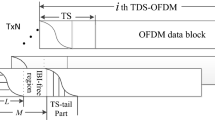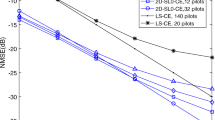Abstract
Acquisition of accurate channel state information (CSI) at transmitters results in a huge pilot overhead in massive multiple input multiple output (MIMO) systems due to the large number of antennas in the base station (BS). To reduce the overwhelming pilot overhead in such systems, a structured joint channel estimation scheme employing compressed sensing (CS) theory is proposed. Specifically, the channel sparsity in the angular domain due to the practical scattering environment is analyzed, where common sparsity and individual sparsity structures among geographically neighboring users exist in multi-user massive MIMO systems. Then, by equipping each user with multiple antennas, the pilot overhead can be alleviated in the framework of CS and the channel estimation quality can be improved. Moreover, a structured joint matching pursuit (SJMP) algorithm at the BS is proposed to jointly estimate the channel of users with reduced pilot overhead. Furthermore, the probability upper bound of common support recovery and the upper bound of channel estimation quality using the proposed SJMP algorithm are derived. Simulation results demonstrate that the proposed SJMP algorithm can achieve a higher system performance than those of existing algorithms in terms of pilot overhead and achievable rate.
Similar content being viewed by others
References
Barbotin, Y., Hormati, A., Rangan, S., et al., 2012. Estimation of sparse MIMO channels with common support. IEEE Trans. Commun., 60(12):3705–3716. https://doi.org/10.1109/TCOMM.2012.091112.110439
Baum, D.S., Hansen, J., Salo, J., 2005. An interim channel model for beyond-3G systems: extending the 3GPP spatial channel model (SCM). IEEE 61st Vehicular Technology Conf., p.3132–3136. https://doi.org/10.1109/VETECS.2005.1543924
Berger, C.R., Wang, Z.H., Huang, J.Z., et al., 2010. Application of compressive sensing to sparse channel estimation. IEEE Commun. Mag., 48(11):164–174. https://doi.org/10.1109/MCOM.2010.5621984
Björnson, E., Larsson, E.G., Marzetta, T.L., 2015. Massive MIMO: ten myths and one critical question. IEEE Commun. Mag., 54(2):114–123. https://doi.org/10.1109/MCOM.2016.7402270
Bogale, T.E., Vandendorpe, L., Chalise, B.K., 2012. Robust transceiver optimization for downlink coordinated base station systems: distributed algorithm. IEEE Trans. Signal Process., 60(1):337–350. https://doi.org/10.1109/TSP.2011.2170167
Chen, Y., Qin, Z., 2015. Gradient-based compressive image fusion. Front. Inform. Technol. Electron. Eng., 16(3):227–237. https://doi.org/10.1631/FITEE.1400217
Choi, J., Love, D.J., Bidigare, P., 2014. Downlink training techniques for FDD massive MIMO systems: open-loop and closed-loop training with memory. IEEE J. Sel. Top. Signal Process., 8(5):802–814. https://doi.org/10.1109/JSTSP.2014.2313020
Dai, L.L., Wang, J.T., Wang, Z.C., et al., 2013. Spectrum-and energy-efficient OFDM based on simultaneous multichannel reconstruction. IEEE Trans. Signal Process., 61(23):6047–6059. https://doi.org/10.1109/TSP.2013.2282920
Dai, W., Milenkovic, O., 2009. Subspace pursuit for compressive sensing signal reconstruction. IEEE Trans. Inform. Theory, 55(5):2230–2249. https://doi.org/10.1109/TIT.2009.2016006
Dasgupta, S., Gupta, A., 2003. An elementary proof of a theorem of Johnson and Lindenstrauss. Rand. Struct. Algor., 22(1):60–65. https://doi.org/10.1002/rsa.10073
Donoho, D.L., 2006. Compressed sensing. IEEE Trans. Inform. Theory, 52(4):1289–1306. https://doi.org/10.1109/TIT.2006.871582
Eldar, Y.C., Kuppinger, P., Bölcskei, H., 2010. Block-sparse signals: uncertainty relations and efficient recovery. IEEE Trans. Signal Process., 58(6):3042–3054. https://doi.org/10.1109/TSP.2010.2044837
Gao, X., Edfors, O., Rusek, F., et al., 2011. Linear pre-coding performance in measured very-large MIMO channels. IEEE Vehicular Technology Conf., p.1–5. https://doi.org/10.1109/VETECF.2011.6093291
Gao, Z., Dai, L.L., Wang, Z., 2014. Structured compressive sensing based superimposed pilot design in downlink large-scale MIMO systems. Electron. Lett., 50(12):896–898. https://doi.org/10.1049/el.2014.0985
Gao, Z., Dai, L.L., Wang, Z., et al., 2015. Spatially common sparsity based adaptive channel estimation and feedback for FDD massive MIMO. IEEE Trans. Signal Process., 63(23):6169–6183. https://doi.org/10.1109/TSP.2015.2463260
Gao, Z., Dai, L.L., Dai, W., et al., 2016. Structured compressive sensing-based spatio-temporal joint channel estimation for FDD massive MIMO. IEEE Trans. Commun., 64(2):601–617. https://doi.org/10.1109/TCOMM.2015.2508809
Hoydis, J., Hoek, C., Wild, T., et al., 2012. Channel measurements for large antenna arrays. IEEE Int. Symp. on Wireless Communication Systems, p.811–815. https://doi.org/10.1109/ISWCS.2012.6328480
Hoydis, J., Ten Brink, S., Debbah, M., 2013. Massive MIMO in the UL/DL of cellular networks: how many antennas do we need? IEEE J. Sel. Areas Commun., 31(2):160–171. https://doi.org/10.1109/JSAC.2013.130205
Hu, D., Wang, X.D., He, L.H., 2013. A new sparse channel estimation and tracking method for time-varying OFDM systems. IEEE Trans. Veh. Technol., 62(9):4648–4653. https://doi.org/10.1109/TVT.2013.2266282
Ketonen, J., Juntti, M., Cavallaro, J.R., 2010. Performancecomplexity comparison of receivers for a LTE MIMOOFDM system. IEEE Trans. Signal Process., 58(6):3360–3372. https://doi.org/10.1109/TSP.2010.2044290
Lee, B., Choi, J., Seol, J.Y., et al., 2015. Antenna grouping based feedback compression for FDD-based massive MIMO systems. IEEE Trans. Commun., 63(9):3261–3274. https://doi.org/10.1109/TCOMM.2015.2460743
Lu, L., Li, G.Y., Swindlehurst, A.L., et al., 2014. An overview of massive MIMO: benefits and challenges. IEEE J. Sel. Top. Signal Process., 8(5):742–758. https://doi.org/10.1109/JSTSP.2014.2317671
Noh, S., Zoltowski, M.D., Sung, Y., et al., 2014. Pilot beam pattern design for channel estimation in massive MIMO systems. IEEE J. Sel. Top. Signal Process., 8(5):787–801. https://doi.org/10.1109/JSTSP.2014.2327572
Qi, C.H., Wu, L.N., 2014. Uplink channel estimation for massive MIMO systems exploring joint channel sparsity. Electron. Lett., 50(23):1770–1772. https://doi.org/10.1049/iet-com.2013.0781
Rao, X.B., Lau, V.K.N., 2014. Distributed compressive CSIT estimation and feedback for FDD multi-user massive MIMO systems. IEEE Trans. Signal Process., 62(12):3261–3271. https://doi.org/10.1109/TSP.2014.2324991
Tropp, J.A., Gilbert, A.C., 2007. Signal recovery from random measurements via orthogonal matching pursuit. IEEE Trans. Inform. Theory, 53(12):4655–4666. https://doi.org/10.1109/TIT.2007.909108
Tropp, J.A., Gilbert, A.C., Strauss, M.J., 2006. Algorithms for simultaneous sparse approximation. Part I: greedy pursuit. Signal Process., 86(3):572–588. https://doi.org/10.1016/j.sigpro.2005.05.030
Tse, D., Viswanath, P., 2005. Fundamentals of Wireless Communication. Cambridge University Press, New York, p.309–330.
Yin, H.F., Gesbert, D., Filippou, M., et al., 2012. A coordinated approach to channel estimation in large-scale multipleantenna systems. IEEE J. Sel. Areas Commun., 31(2):264–273. https://doi.org/10.1109/JSAC.2013.130214
Zhang, Z.Y., Teh, K.C., Li, K.H., 2014. Application of compressive sensing to limited feedback strategy in largescale multiple-input single-output cellular networks. IET Commun., 8(6):947–955. https://doi.org/10.1049/iet-com.2013.0781
Author information
Authors and Affiliations
Corresponding author
Additional information
Project supported by the Fundamental Research Funds for the Central Universities (No. HIT.MKSTISP.2016 13) and the National Natural Science Foundation of China (No. 61671176)
Rights and permissions
About this article
Cite this article
Zhang, Ry., Zhao, Hl. & Jia, Sb. Compressed sensing-based structured joint channel estimation in a multi-user massive MIMO system. Frontiers Inf Technol Electronic Eng 18, 2082–2100 (2017). https://doi.org/10.1631/FITEE.1601635
Received:
Accepted:
Published:
Issue Date:
DOI: https://doi.org/10.1631/FITEE.1601635
Key words
- Compressed sensing
- Multi-user massive multiple input multiple output (MIMO)
- Frequency-division duplexing
- Structured joint channel estimation
- Pilot overhead reduction




